(Gasp!) Watson Was Right
The Former Chief, the Audit, the Research All Say: We Need Community Policing
By Louisa C. Brinsmade, Fri., March 21, 1997
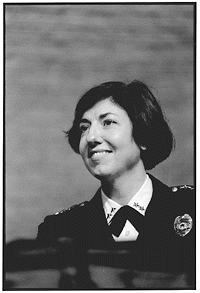
Former APD Chief Elizabeth Watson may have been right about community policing, but Austin needs a more effective leader to pull it off |
In the wake of all this bad news, city leaders met with East Austin residents on their own turf to talk about public safety (or the lack of it). The crowded public meeting, held at the Conley-Guerrero Senior Center on Nile Street on Feb. 27, was more than an acknowledgment of the disproportionate amount of crime on the East side, or a reaction to an unfavorable audit, it was an unspoken confession that current policing methods are not working. Citizen after citizen battered the mayor and councilmembers with complaints about such issues as environmental racism, their desire for more police presence, and the need for more crackdowns on rampant drugs, gangs, and graffiti. The most poignant testimony came when Antoinette Humphrey rose to speak at the very end of three exhausting hours of public comment. When Humphrey, 33, bought her modest home right across the street from the center, she told the council, she was elated at finally realizing the American Dream. That was three years ago.
"I'm standing here today, about to move," Humphrey said firmly. "It's not the same as it was three years ago. There's shooting at night around 2am, and my baby's three months old. I can't keep her next to the window because I'm afraid -- it shouldn't be like that." Humphrey, employed by the Texas Department of Housing and Community Affairs, broke down and cried as she related her concerns about the unsafe conditions in her neighborhood. "I'm proud of this community, but I'm scared of this community," she confessed. "I wish I was brave enough to stay here, but I'm not.... When they said my loan would go through, I praised God, and I said I'm getting out of here."
APD leaders are defensive about the latest hoopla, particularly when the most recent crime stats from 1996 show that violent crime is down by 3.2%, and property crimes are down slightly as well. Austin ranks a respectable second to last --15th out of 16 comparable cities -- with regards to violent crime, and 11th out of 16 in overall crime index per capita. Indeed, crime may be slowing in Austin, but the perception of crime is not. The reason may be relatively simple: Austin's most troubled neighborhoods do not feel empowered to stop crime, and their greatest tool for conquering their fear -- a close relationship to the police -- remains a distant promise.
Which is odd, because APD was supposed to be making the big switch from a purely reactive form of policing to a nationally proven method of crime prevention and crime-fighting called community-oriented policing. It's an old idea wrapped in a new package: good, old-fashioned, street-level police work enabled by a close partnership with the community. It's the kind of policing that helps residents like Humphrey remained invested in her neighborhood as part of "the solution," instead of as a victim who can't wait to move away. APD's champion of community policing, former Chief Watson, introduced the idea as long ago as 1992, but in the end, it never really caught on at the most important level: Among the very officers who are supposed to carry it out. Despite Watson's accomplishments in forming the Chief's Forum of 24 neighborhood representatives and in restructuring the department leadership to reintroduce the tradition of "cops on the beat," the audit and interviews with APD leadership reveal that community policing in Austin remains a jingoistic, feel-good concept for most neighborhoods, successful only in the abstract.
Fear and Loathing in
Your Neighborhood
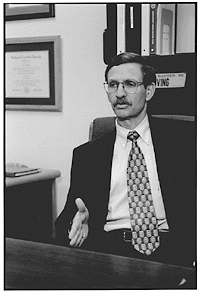
Interim APD Chief Bruce Mills |
Community policing is supposed to reverse all that by encouraging police departments to get back to basics with foot patrols, decentralized police forces, police/resident informational meetings, and resident surveys. For many cities it works extremely well. San Diego, El Paso, Madison, Wisconsin, and even New York City have model community policing programs. The biggest success story seems to be San Diego, in which overall crime incidents have decreased by 43% since 1992, even with a 4% increase in population, and with only 1.7 officers per 1,000 citizens -- a much lower ratio than the federal recommendation of three officers per 1,000 residents. (Austin currently has 1.8 officers per 1,000 residents.) El Paso went "full blown" on community policing in 1995, according to its police officials, and the plan is definitely working. Since 1992, El Paso's population has increased by 10%, but crime has gone down 16%. El Paso also succeeds with 1.7 officers per 1,000 citizens. In cities without a working community policing plan, the contrast is startling. Tucson, for example, a city which has grown 6% in population since 1992, suffers from an overall crime increase of 23%, despite having over 2.5 officers for every 1,000 residents. Tucson is coming around, however, having just developed a pilot program last summer called Geo-Policing, designed to bring cops closer to the community.
In San Diego and El Paso, officials report that their neighborhoods are not only safer, but most importantly, residents feel safer. How important is it that residents feel safer, especially if their neighborhood is not? Studies from the Police Foundation show that even in communities that improved their police presence with more officers on foot patrol, communities weren't necessarily safer. Yet the studies, conducted primarily in Newark, New Jersey and in Flint, Michigan, revealed that foot patrols eased citizens' fear of crime, made them feel safer, and improved the community's satisfaction with police work. And those programs, combined with other community-based efforts, go a long way toward fighting crime's greatest enablers: fear and silence. As noted by the Community Policing Consortium, a division of the U.S. Department of Justice's Office of Community Oriented Policing Services (COPS), such fear-reduction studies "proved the effectiveness of key community policing tactics like community organizing, door-to-door contacts, neighborhood mini-stations, and intensified enforcement coupled with community involvement in reducing fear among residents, improving community conditions, and enhancing the image of the police." The hope is that if fear could be reduced, community residents would be more inclined to take an active role to help police preserve safety and tranquility within their neighborhoods. Further, the Consortium determined that "community policing produces improved relations between people and their police as a welcome by-product of delivering high-quality decentralized and personalized police service to the community at the grass-roots level."
To that end, El Paso officials committed to a restructuring of the police department, the construction of substations in every sector of town, and galvanized the entire community to pitch in and help. "An active community makes it easier to fight crime," says Sgt. Bill Pfeil in El Paso, adding that the city has "an extensive volunteer force that complements our police work." In all the above model cities, crime prevention duties through programs and neighborhood meetings became as important as the basic, but essential, call-response service all departments provide.
You Win Some,
You Lose Some
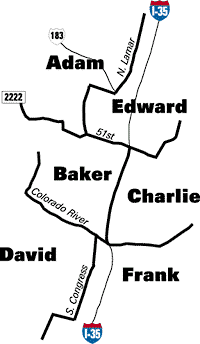 APD uses 6 names to label different areas of the city |
Certainly Watson's community policing plan had the beginning elements of success: The police chief changed the department's mission statement to reflect a commitment to community service and partnership; she opened eight neighborhood centers to serve as liaisons between the community and the police (see box) and created the Chief's Forum of 24 neighborhood representatives from the six city sectors, who meet monthly to discuss problems in their communities with the police; in 1995, she flattened management by eliminating the five deputy chief positions to encourage the quicker flow of information from the lower-ranked officers to upper management; and to help maintain quick response time, Watson won funding for 57 more cops on the street over the last three years. Finally, she implemented a six-sector lieutenant plan in 1995, calling it the "flagship" program of community policing for Austin. In each sector of the city, about 70 patrol officers are designated within each area under one lieutenant who is accountable on a 24-hour basis for his "beat." The idea was to empower the leader of each sector to come up with crime prevention and crime-fighting strategies specifically designed for his or her area.
In certain Austin neighborhoods, community policing is working, but only in the most organized areas. In the "David" sector of central South Austin -- south of the river, between Congress and Lamar -- neighborhood leaders say the police have worked hard with them to clean up long-standing prostitution and gang problems. The recent sting operation on South Congress that nabbed Texas State Senator Drew Nixon (R-Carthage) was a high-profile strategy that worked well with resident support. Chief's Forum representative Scott Bennett calls police efforts during that sting "outstanding," and says he's proud of the "two-way communication and partnership between our community and law enforcement." Bennett confirms that the neighborhood started becoming tightly organized around 10 years ago, and that that is likely the reason community policing works so well for South Austin. Another Chief's Forum representative, Jerry Hill of the "Frank" sector of Southeast Austin, also commends APD for its efforts to help clean up graffiti and curb truancy. Hill can, like few residents in other areas of town, name the point officer for his community. "Officer Roger Bahr came to our meetings, alerted us to problems and was a source of information. But our neighborhood group is pretty active, so we work well together."
In other areas of town, namely East and Northeast Austin, neighborhood groups have sometimes faltered in their attempts to organize successfully, and in high-crime areas, the priority is reactive policing. Over half of APD's crime fighting resources are spent in East Austin alone. As Watson pointed out in an interview during her last week as chief -- along with a concentration of patrol officers, APD's gang unit, narcotics unit, and Crime Net unit each spend 50% of their time on the East side. But those efforts consist of throwing bodies at the problem without enacting community policing principles. Making it more difficult is the fact that the areas that need the most help -- such as parts of Coronado Hills, Craigwood, and the Manor and Loyola areas -- do not have well-organized neighborhood associations, and most of the pressure on police to "do something" about shootings, open drug-dealing, gangs, and assaults, comes from surrounding neighborhoods.
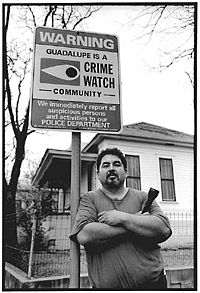
Guadalupe resident David Zapata |
One exception to the East Austin syndrome of scant community participation is the Guadalupe neighborhood between East 11th Street -- a high crime area -- and East Seventh. Guadalupe residents have been successful in using not only the police, but city programs and housing codes to clean up street drug-dealing, prostitution, vagrancy, graffiti, and alcohol abuse that plagued their historic area near the French Legation. Lifetime resident David Zapata was a key organizer, who began trekking from house to house in 1991 getting neighbors to rally around the Neighborhood Watch program. "We have 100% participation in the neighborhood. That's the only way it will work -- people have to get involved, have to want it. Police can't be everywhere all the time. People feel safe now walking around -- that wasn't true ten years ago." Zapata took a very personal approach to the problem, as did his neighbors. "When I first started, I got all the prostitutes on the corner and talked to them -- said you have to do what you have to do, but not in my neighborhood or I'll call the law. Out of respect for our efforts, they didn't come into our neighborhood. They really just didn't want that hassle, so we had an understanding."
Zapata says he and his neighbors aren't going to wait for the police to target their neighborhood, particularly since the neighborhood has seen a young crack-selling crowd creeping over onto their quiet street recently. "I've parked up on the hill by San Marcos and E. 11th, and seen the police parked one block down with street people selling crack right near them. I don't know if they're ignoring the problem, or what. To be honest, we have relaxed and started to see a wave of crime again. Fighting crime is a constant job. I think I've learned a lesson that you can't ever let up. So we're back to fighting crime again, and we'll need to get it back to where we had our serenity."
A Leader of One
Why is community policing reaching some parts of the city and not others? At least part of the responsibility apparently rests with APD leadership. Watson's plan was a progressive start for Austin, but what remained out of her reach was the one thing all leaders need: followers. Watson's ability to lead her police officers suffered often during her four-year tenure -- from a distrust in the ranks over her lack of patrol experience to dissatisfaction over her implementation of community policing. Specifically, her elimination of the deputy chief positions rankled officers, since it was a level of command to which they could have been promoted. The police culture is traditionally resistant to change, but many police forces in other cities have been able to overcome fear of change with strong leadership. In Austin, the resistance continues -- perhaps most importantly, say the leaders of the Austin Police Association, because Watson was unable to communicate her vision effectively. In the words of one sector lieutenant, Manuel Peña, who oversees the Central East Austin area, or "Charlie" sector, Watson "probably could have done a better job of selling herself to the force -- she ended up setting herself apart. If a police chief doesn't enjoy support from the people they work with, they're not going to be successful."
That reason alone made it difficult for Watson and her assistant chiefs to lead the force into a new era of community policing. It wasn't that APD's 957 police officers didn't agree with her -- the audit's survey of officers shows that only 1% of them are totally against community policing. Instead, it seems, the rank and file don't really understand what they're supposed to be doing. According to the audit, major strategies to implement community policing in Austin have suffered because of a lack of communication, and a lack of consensus in upper management on how to deploy officers: "Very little education for decision makers as to the nature of community policing has taken place. One result of the lack of education is the continuing debate over the number of officers needed on patrol. APD as well as city policy makers focus on the number of officers on the street as opposed to the method in which the officers are deployed, which could have a more significant impact on crime. In fact, to effectively implement community policing, it is necessary that nontraditional methods of deployment be utilized since the needs of each neighborhood will vary."
Last fall, during the budget season, Watson and APD came under fire from the city council due to some unanticipated expenses from the prior year's budget. It was during this time that the city audit was scheduled, but notably, the council seemed primarily concerned with sexier topics than finances -- such as increasing the ratio of officers to citizens to improve response time. Certainly Watson was interested in increasing the number of police on the streets, but she also took that time to introduce to the council her plan to commit one-third of the her force's time to community policing efforts. It was a politically charged topic: Sometimes community policing is at odds with a priority in the community for quicker response time (i.e. a larger police force). Yet studies indicate that fast response time has no connection to better crime-solving, while crime prevention with community participation, in fact, does. A Law Enforcement Assistance Administration project called the Kansas City Response Time Study and a later National Institute of Justice replication of the study in several other cities indicate that there is no relationship between a rapid crime scene response and the apprehension of criminal perpetrators.
APD is currently understaffed, according to the number of officers it's authorized to hire, by about 100 officers, a fact that slows APD response time. The city currently has three cadet classes in training, with 35 of those cadets hitting the streets this summer. Yet Austin still maintains a higher ratio -- at 1.8 officers per 1,000 residents -- than other cities with successful community policing programs. Still, Austin Police Association members and middle-command officers cite the missing officers as the reason that community policing is not possible at this time. "I agree with community policing to a point," says APA president Sgt. Mike Lummus, who was a frequent critic of Watson, "but the real problem is the 100 officers we need to make it happen." Lummus is pushing a $10 million plan to provide a police car for every officer (currently the cars are available only while on a shift) to both patrol on the job and to commute to work. Lummus adds that his vehicle idea also constitutes community policing since it improves police presence. In terms of expense, "it's a front end-loaded plan, but later it begins to pay off," he says.
The council is likely to balk at Lummus' suggestion, but what the APA leader is definitely interested in, he says, is lifting morale. That's something community policing -- in its less expensive form of asking police to partner up with residents on strategies -- is not likely to do immediately. Many officers see that kind of police work as simply "pacifying" residents while their response time slips through the cracks. It takes more time and energy than many APD officers are willing to give, or even know how to give.
The Information Vacuum
Certainly, the lack of training on this new thing called community policing is causing confusion for the officers. But it's the sector lieutenants, the "flagships" guiding the officers, who are really not ready for the new era. Interim Chief Bruce Mills says that community policing has been "institutionalized" in the force already, but the audit reveals that "empowerment has been neither adequately defined nor formally assigned," among sector lieutenants. The audit goes on to say that sector lieutenants are divided over whether they feel empowered to do their job, but certainly "there is some confusion as to the level of authority and responsibility that has been vested in them. The sector lieutenants have been submitting official `Sector' plans since 1993. As of our last discussions with them in the fall of 1996, none received approval to implement the submitted plans. The sector lieutenants reported having implemented varying levels of their plans without approval." Interim Chief Mills adds that there is not enough crime analysis or management information given to sector lieutenants for them to draft effective strategies for dealing with neighborhood issues, nor is there a system to collect feedback on any initiatives that might be implemented.
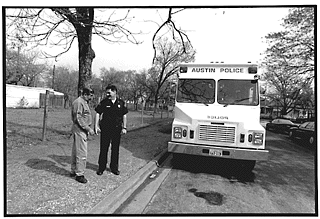
Police Lt. Manuel Peña (right) doesn't think community policing, as a whole, has been a failure, but "it has been a disappointment" |
A visit to the East Austin substation gave evidence to the audit's results and Mills' beliefs. Peña agrees that things are not quite as great on the community policing front as they could be. "More often than not, we just don't have the time," he concedes. But it's not just the time factor. "Community policing was never committed to in attitude," he confides. "And I just don't remember any of us being given any instruction or knowledge of it. They really dropped the ball on this thing." As for the rank and file, Peña concurs with the audit. "A lot of officers didn't see any benefit, and thought that, in fact, it could make their jobs a lot harder. They really were not educated on how it would help them in the long run. Unless you have that officer out there dedicated to seeing some results, no program is going to be successful. In Austin, I think that's a problem."
Community policing, as a whole, has not been a failure in Peña's opinion, but "it has been a disappointment." Peña says that as sector lieutenant, he tries to stay in contact with the community and encourages his officers to do the same, but he acknowledges that there is no formal structure for doing that. Whenever he can make it to a neighborhood meeting, he tries to go and listen. But again, that is the only method he has for receiving information from the community. He points to the Chief's Forum as a way for upper management to stay informed by neighborhood representatives, but he adds that that information, as noted in the audit, rarely makes its way down to the people in charge of the sectors.
Watson called community policing "attitudinal rather than procedural" in nature -- a concept with which Interim Chief Mills concurs. That definition may be correct, but it's telling that Austin's community policing is not working in the most troubled neighborhoods beyond the merely hypothetical. If Austin could get more police officers, if neighborhoods in those areas were better organized, if APD could choose a new police chief with leadership skills... if, if, if. But consider the value of using the resources the police department currently has, and making a commitment to change right now. The investment could mean lower crime rates for generations.
Imagine how difficult it is to stay straight when you grow up surrounded by garbage, drug dealers, prostitutes, and drunks. Imagine trying to find a place for good values in your life if the only people who really make any money are criminals. In our current urban environment, says Robert Trojanowicz of the National Center for Community Policing, "the question becomes why there is any resistance to community policing reform. Part of the reluctance to make the shift to community policing stems from a basic resistance to change. Yet resistance also stems from the fact that community policing is people-intensive, and high-touch is often more expensive than high-tech. But while a new computer may make police more efficient, when it comes to helping young people grow up to live within the law, nothing can beat the human touch."
Got something to say on the subject? Send a letter to the editor.






